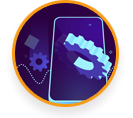TrackSchoolBus Implementation Plan
Onboarding the TrackSchoolBus tracking system is made easy and simple by a clear-cut ‘Implementation Plan’ regardless of your fleet size.


Hassle-free
Data Transfer

Simple
Installation Process

Highly
Safe & Secure

Easy
to operate

Simple
Learning Curve
Setting up would be the most difficult part of a school bus tracking system. Almost always, there is a lot of data involved. This data needs to be handled in a simple and clear manner without any errors.
There are two types of approaches

Manual Implementation

Automated Implementation
Automated Implementation Approaches
Old Data, New Software approach Integration with Customer’s existing software
Old Data, New Software approach can be best implemented if you have an existing data which is accurate and error-free, this would be very helpful. It can ease the transition from old software to the new one. Without any trouble data can be easily integrated to new software. Only caveat is that if the data is not really accurate, it can be messy.


Advanced and Hassle-Free
Auto data collection method
This is the most advanced method of collecting data. Ideal choice if there is no existing data. It is a simple process where the system collects student data on the run. It will require a week’s time to get going 100%, but is a hassle-free approach especially if you have a large fleet.
In this approach, drivers take school bus rides as usual and students tap their RFID cards on readers during entry and exit. Details such as student profile data, punch in/out time and stop are all collected on the trip by the system.
Once all relevant data is acquired and refined over a minimum period of 1 week, the system would be all good to go after approval from Transport Manager.
Drivers can access the approved trips data through “Driver’s App”. This approach can be very useful if no previous data exist and you have a large fleet to manage. It helps to implement the tracking system very quickly in a large fleet of school buses with minimal error.
Artificial Intelligence Smartness!
Route Planner Method
This is a fairly simple method, where the data is available in a commonly used format (excel, csv). The available data needs to be uploaded. Our smart A.I then kicks in and analyzes the data, to create the best optimized routes possible.
Transport Manager can then look at the route, make changes if necessary and approve. This can help find the best routes from an ROI perspective as well.
In this module, supporting staff will import data to “Route Planner”module, including seat capacity. Route planner analyzes data and creates best optimized routes.
Transport manager can review and edit trips accordingly and will approve the finalized trip. “Tag vendor module” will print cards. After trials, system will go live. Integration with AI will make the approach quite an easy one!

Why accurate data transfer matters?
TrackSchoolBus places lot of importance to accurate, relevant and error-free data transfer while on-boarding due to simple reasons.
- Accurate data transfer results in smooth fleet operation
- Data accuracy augurs well for student safety
- Accurate data results in optimal operating costs
- Manual intervention can be kept to a minimum


Importance of School Bus Tracking System Implementation Plans
The key challenge for adapting to a new school bus tracking system is usually data transfer. TrackSchoolBus tackles this with two types of approaches –manual, which is ideal for smaller sized fleets and automated, the better choice for larger fleets.
The TrackSchoolBus implementation processes are carefully crafted and continuously improvised using our learning from previous on-field experiences. It helps to set a hassle free, safe and efficient bus transport system.